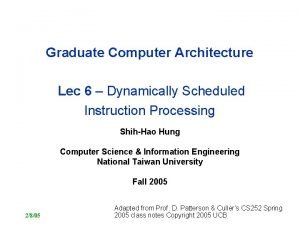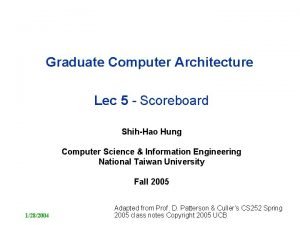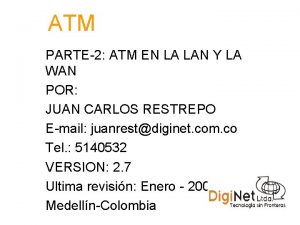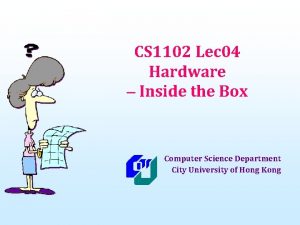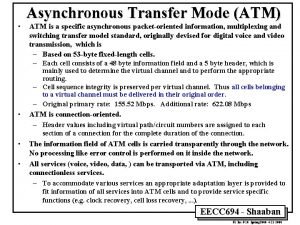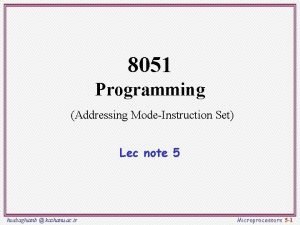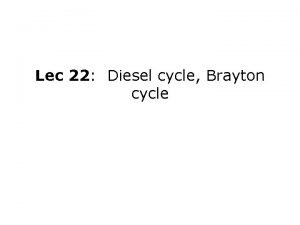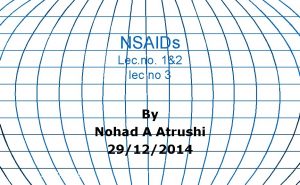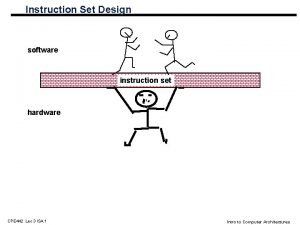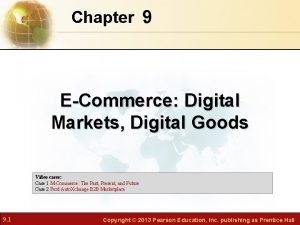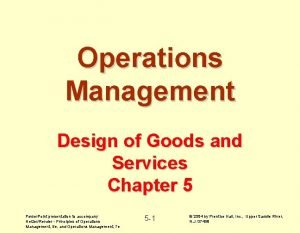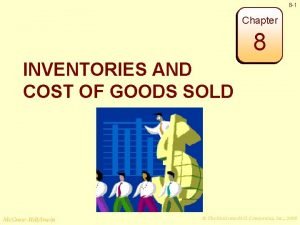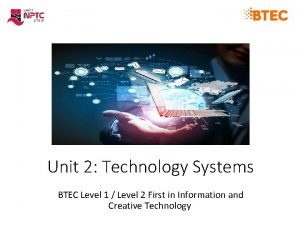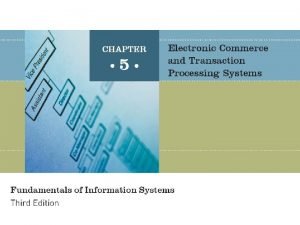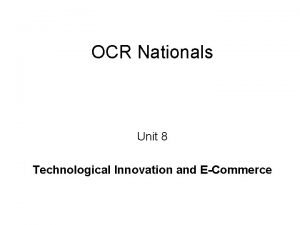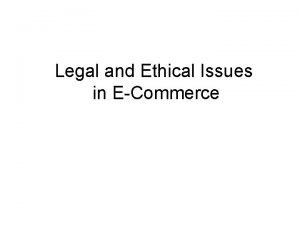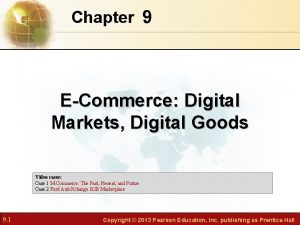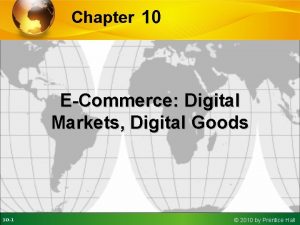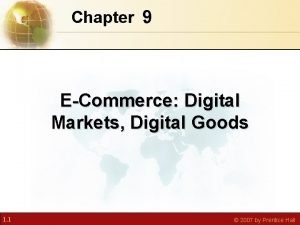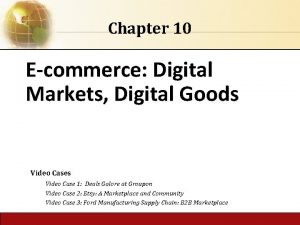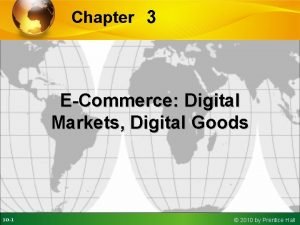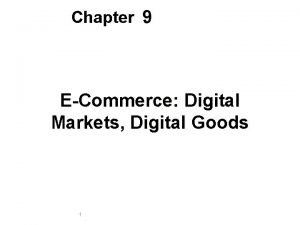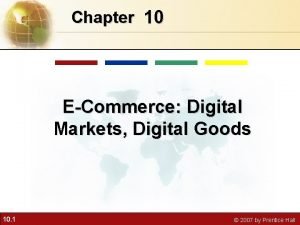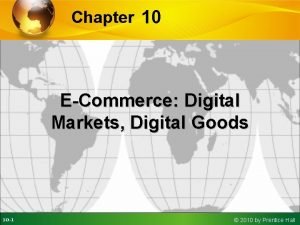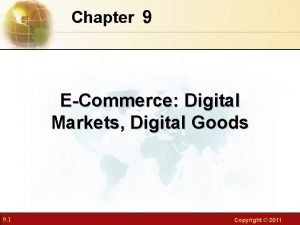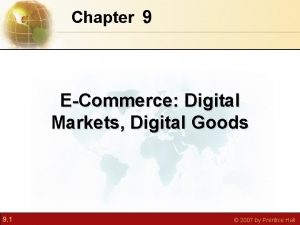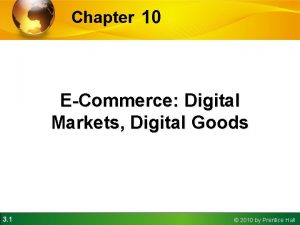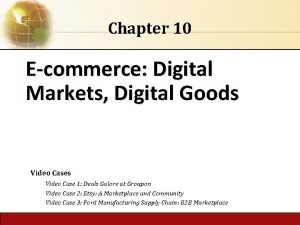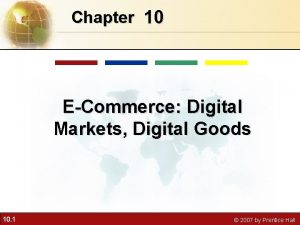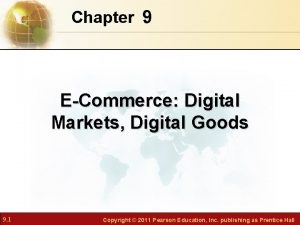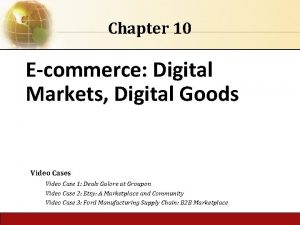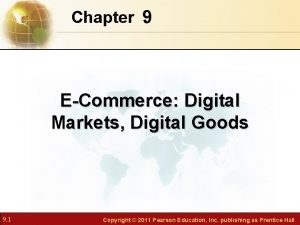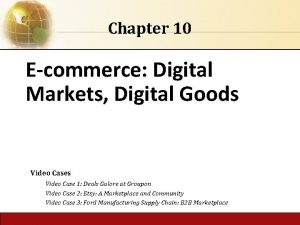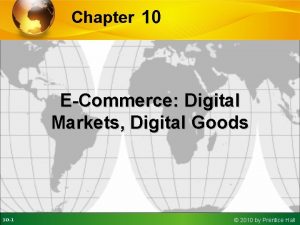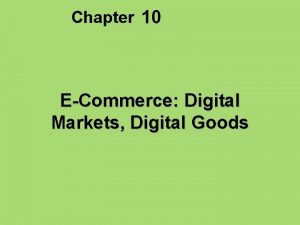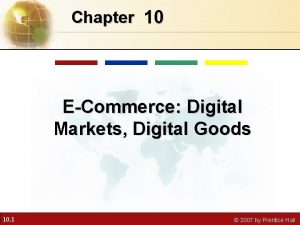Chapter 10 ECommerce Digital Markets Digital Goods LEC
























































- Slides: 56

Chapter 10 E-Commerce: Digital Markets, Digital Goods LEC 19, 20, 21 10. 1 © 2010 by Prentice Hall

Management Information Systems Chapter 10 E-Commerce: Digital Markets, Digital Goods LEARNING OBJECTIVES • Identify the unique features of e-commerce, digital markets, and digital goods. • Describe how Internet technology has changed business models. • Identify the various types of e-commerce and explain how e-commerce has changed consumer retailing and business-to-business transactions. • Evaluate the role of m-commerce in business 10. 2 © 2010 by Prentice Hall

Nexus Games: E-Commerce Goes Social • The opening case describes the business model of Nexon Games, which creates popular online games. • While the basic games are provided for free, users must pay for game enhancements, such as ingame virtual items. • Nexon games exemplify new face of ecommerce. • Users can link with other users and interact. 10. 3 © 2010 by Prentice Hall

Management Information Systems Chapter 10 E-Commerce: Digital Markets, Digital Goods Nexus Games: E-Commerce Goes Social • Problem: Building a business model that serves the emerging market for social networking sites. • Solutions: Sell games that are social experiences. Online users can access full games for free but must pay for any “virtual items” to enhance game play – Micro transaction business model – Playing up social features of online games and paying online micro payments for small purchases. – Introduce Social gaming • Nexon games all feature Forums where users can socialize, share tips 10. 4 • Demonstrates digital technology’s role in generating new business models © 2010 by Prentice Hall

Management Information Systems Chapter 10 E-Commerce: Digital Markets, Digital Goods Electronic Commerce and the Internet • E-commerce • Use of the Internet and Web to transact business • Digitally enabled transactions btw and among organizations and individuals. • Ecommerce is more than just buying and selling products online. It is: The online process of developing, marketing, selling, delivering, servicing, and paying for products & services transacted on internet. • Those activities which essentially involve monetary transactions are termed as "e-commerce”. 10. 5 © 2010 by Prentice Hall

Ecommerce and E-business difference • In all, e-commerce can be described as the use of the Internet and the web to transact business. More formally, digitally enabled commercial transactions between and among organizations and individuals. • On the other hand, e-business can be described as the digital enablement of transactions and process within a firm, involving information systems under the control of the firm. Moreover, e-business applications turn into e-commerce precisely when an exchange of value occurs. 10. 6 © 2010 by Prentice Hall

Electronic Commerce and the Internet History of e-commerce – Began in 1995 and grew exponentially; still growing at an annual rate of 16 percent – Rapid growth led to market bubble in 2001. – While many companies failed, many survived with soaring revenues. eg Amazon, e. Bay survived. – E-commerce today the fastest growing form of retail trade in U. S. , Europe, Asia 10. 7 © 2010 by Prentice Hall

Management Information Systems Chapter 10 E-Commerce: Digital Markets, Digital Goods Electronic Commerce and the Internet The Growth of E-Commerce This graphic illustrates the continuing growth of e-commerce. The dot-com bubble burst in March 2001. Retail e-commerce revenues have grown exponentially since 1995 and have only recently “slowed” to a very rapid 16 percent annual increase, which is projected to remain the same until 2010. Figure 10 -1 10. 8 © 2010 by Prentice Hall

Why E-commerce is different • Why e commerce is growing so rapidly? • Answer lies in the unique nature of the internet and web. • Internet and ecommerce technologies are much more rich. • Powerful than previous technology revolutions like radio, TV and telephone. 10. 9 © 2010 by Prentice Hall

Management Information Systems Chapter 10 E-Commerce: Digital Markets, Digital Goods Electronic Commerce and the Internet • Eight unique features of e-commerce 1. Ubiquity • • 10. 10 Internet technology available anytime and everywhere: work, home, mobile devices Business significance: • Marketplace is extended beyond traditional boundaries and is removed from temporal and geographic location • Creates marketspace: Marketplace extended beyond traditional temporal, geographical boundaries • Shopping can take place anywhere - customer convenience is enhanced, shopping costs are reduced and transaction cost reduced. © 2010 by Prentice Hall

Management Information Systems Chapter 10 E-Commerce: Digital Markets, Digital Goods Electronic Commerce and the Internet 2. Global reach 10. 11 • Technology reaches across national boundaries, around Earth • Business significance: • Commerce enabled across cultural and national boundaries seamlessly, without modification • Marketspace includes potentially billions of consumers and millions of businesses worldwide © 2010 by Prentice Hall

Management Information Systems Chapter 10 E-Commerce: Digital Markets, Digital Goods Electronic Commerce and the Internet 3. Universal standards 10. 12 • There is one set of Internet technology standards • Business significance • Disparate computer systems can easily communicate • Brings lower market entry costs (costs merchants pay to bring goods to market) • Lowers search costs for consumers © 2010 by Prentice Hall

Management Information Systems Chapter 10 E-Commerce: Digital Markets, Digital Goods Electronic Commerce and the Internet 4. Richness • Video, audio, text messages are possible • Business significance: Video, audio, text integrated into single marketing message and experience 5. Interactivity 10. 13 • Technology works through interaction with user • Business significance: Consumers engaged in dialog that adjusts to individual; consumer is co-participant in delivering goods to market © 2010 by Prentice Hall

Management Information Systems Chapter 10 E-Commerce: Digital Markets, Digital Goods Electronic Commerce and the Internet 6. Information density 10. 14 • Technology reduces information costs and raises quality • Business significance: • Information becomes plentiful, cheap, and more accurate • Increases price transparency and cost transparency (ability of the consumers to discover actual cost merchants pay for goods) • Enables price discrimination, e-ticketing © 2010 by Prentice Hall

Management Information Systems Chapter 10 E-Commerce: Digital Markets, Digital Goods Electronic Commerce and the Internet 7. Personalization/customization • Technology allows personalized messages to be delivered to individuals as well as groups • Permits customization—changing delivered product or service based on user’s preferences or prior behavior • Business significance • 10. 15 Personalization of marketing messages and customization of products and services are based on individual characteristics © 2010 by Prentice Hall

Management Information Systems Chapter 10 E-Commerce: Digital Markets, Digital Goods Electronic Commerce and the Internet • Eight unique features (cont. ) 5. Social technology 10. 16 • The technology promotes user content generation and social networking • New Internet social and business models enable user content creation and distribution, and support social networks. © 2010 by Prentice Hall

Management Information Systems Chapter 10 E-Commerce: Digital Markets, Digital Goods Electronic Commerce and the Internet • Key concepts in e-commerce • Digital markets reduce • Information asymmetry • Search costs • Transaction costs • Menu costs • Digital markets enable 10. 17 • Price discrimination • Dynamic pricing • Disintermediation © 2010 by Prentice Hall

Management Information Systems Chapter 10 E-Commerce: Digital Markets, Digital Goods Electronic Commerce and the Internet • Key concepts in e-commerce: Digital markets and digital goods • Internet shrinks information asymmetry • Information asymmetry: when one party has more information important for transaction • E. g. Information asymmetry between auto dealers and customers 10. 18 © 2010 by Prentice Hall

Key concepts in e-commerce: Digital markets and digital goods (cont. ) – Digital markets more flexible and efficient • Reduced search cost: The effort to find suitable products • Reduces transaction costs: The cost of participating in a market • Lower menu costs (cost to a merchant of changing prices) 10. 19 © 2010 by Prentice Hall

Key concepts in e-commerce: Digital markets and digital goods (cont. ) –Digital markets enable • Price discrimination Selling the same goods, or nearly the same goods, to different targeted groups at different prices. EX: Movie theaters, buses, trains, airlines, and even amusement parks and restaurants, engage in a form of price discrimination when they offer discounts for children, students, or senior citizens • Dynamic pricing The price of a product varies depending on the demand characteristics of the customer or the supply situation of the seller. EX: Customers of Amazon. com, the be-commerce retailer, were recently startled and quite upset when they learned that the online mega-store was charging different customers different prices for the same DVD movies • Refer to table 10 -3 10. 20 © 2010 by Prentice Hall

Management Information Systems Chapter 10 E-Commerce: Digital Markets, Digital Goods Electronic Commerce and the Internet • Key concepts in e-commerce: Digital markets and digital goods (cont. ) • Internet enables disintermediation • Disintermediation: • Removal of organizations or business process layers responsible for intermediary steps in value chain • Enables selling direct to consumer 10. 21 © 2010 by Prentice Hall

Management Information Systems Chapter 10 E-Commerce: Digital Markets, Digital Goods Electronic Commerce and the Internet The Benefits of Disintermediation to the Consumer The typical distribution channel has several intermediary layers, each of which adds to the final cost of a product, such as a sweater. Removing layers lowers the final cost to the consumer. Figure 10 -2 10. 22 © 2010 by Prentice Hall

Management Information Systems Chapter 10 E-Commerce: Digital Markets, Digital Goods Electronic Commerce and the Internet • Key concepts in e-commerce (cont. ) • Digital goods (refer to table 10 -4) • Goods that can be delivered over a digital network • E. g. , Music tracks, video, software, newspapers, books • Cost of producing first unit almost entire cost of product: marginal cost of producing 2 nd unit is about zero • Cost nothing to produce a copy of a music file. • Costs of delivery over the Internet very low • Marketing costs remain the same; pricing highly variable • Industries with digital goods are undergoing revolutionary changes (publishers, record labels, etc. ) 10. 23 © 2010 by Prentice Hall

Management Information Systems Chapter 10 E-Commerce: Digital Markets, Digital Goods Electronic Commerce and the Internet • Internet business models • Pure-play models • Clicks-and-mortar models Pure play models • Social Network • Link people through their mutual business or personal connections • • Have become powerful marketing tools for businesses • Can provide ways for corporate clients to target customers through banner ads and pop-up ads Social shopping sites: Online meeting places where people swap shopping ideas • Online marketplace: • 10. 24 Provides a digital environment where buyers and sellers can meet, search for products, display products, and establish prices for those products © 2010 by Prentice Hall

Management Information Systems Chapter 10 E-Commerce: Digital Markets, Digital Goods Electronic Commerce and the Internet • Virtual storefront: • Sells physical products directly to consumers or to individual businesses • E. g. : e. Bay hosts thousands of virtual store fronts. • E. g. : Amazon. com • Information broker: • Provides product, pricing, and availability information to individuals and businesses. Generate revenue from advertising or directing buyers to sellers. . E. G Kbb. com • Transaction broker: • Saves users money and time by processing online sales transactions and generating a fee for each transaction. E. g Etrade. com 10. 25 © 2010 by Prentice Hall

Management Information Systems Chapter 10 E-Commerce: Digital Markets, Digital Goods Electronic Commerce and the Internet • Content provider • Providing digital content, such as digital news, music, photos, or video, over the Web. Revune generated customer pay to access content. E. g itunes. com, CNN. com • Online syndicators: Aggregate content from multiple sites, package for distribution, and resell to third-party Web sites. • Service provider • Provides Web 2. 0 applications such as photo sharing and interactive maps, and services such as data storage. E. g Youtube. • Portal • 10. 26 “Supersite” that provides comprehensive entry point to the web, for huge array of resources and services on the Internet. Revenue derived from advertising. E. g yahoo © 2010 by Prentice Hall

Business models • Pure-play business models • Clicks-and-mortar models( clicks-and-bricks) – Based purely on Internet – Do not have bricks-and-mortar portion of business – E. g. Amazon. COM, e. Bay. COM, You. Tube. com – Internet presence is extension of bricks-and-mortar businesses – type of business model that includes both online and offline operations, which typically include a website and a physical store. A click-and-mortar company can offer customers the benefits of fast, online transactions or traditional, face to face service. This model is also referred to as "clicks and bricks". – One example of the bricks-and-clicks model is when a chain of stores allows the user to order products online, but lets them pick up their order at a local store – E. g. L. L. Bean, Office Depot, Wall Street Journal 10. 27 © 2010 by Prentice Hall

Management Information Systems Chapter 10 E-Commerce: Digital Markets, Digital Goods Electronic Commerce Types of Electronic Commerce Classify according to nature of participant • Business-to-consumer (B 2 C) when a business sells products and services to individuals, most consumers deal directly with a chosen business on the Internet • E. g. Barnesandnoble. com • Business-to-business (B 2 B) when a business sells products and services to customers who are primarily other businesses, typically a manufacturer-supplier relationship • E. g Intel selling micro processors to Dell Heinz selling ketchup to Mc Donald's • E. g. Chem. Connect. com • Consumer-to-consumer (C 2 C) E. g. e. Bay. COM 10. 28 © 2010 by Prentice Hall

Management Information Systems Chapter 10 E-Commerce: Digital Markets, Digital Goods Electronic Commerce and the Internet Another way to classify is according participant physical connection. • Until recently all ecommerce took place over wired network. • Now wireless means: through M commerce Mobile commerce (m-commerce) Use of handheld wireless devices for purchasing goods and services from any location 10. 29 © 2010 by Prentice Hall

Management Information Systems Chapter 10 E-Commerce: Digital Markets, Digital Goods Achieving customer intimacy: Interactive marketing Use of Internet-based techniques for achieving greater customer intimacy. • Interactive marketing and personalization • Enabled by gathering customer data from Web site registrations or activities • E. g: Nike (Athletic shoes) encourage customers to participate in designing products. • Web sites have become bountiful source of details about customer behavior, preferences, buying patterns used to tailor promotions, products, services, and pricing • Ask to register online others use software tools that track activities. 10. 30 © 2010 by Prentice Hall

Achieving customer intimacy: Interactive marketing Click stream tracking tools • Collect data on customers activities at websites and stores them in a log. • Record activities prior to and after visiting the site. • Record pages visited on the site, type of pages visited. • Purchases made. • Develop profiles of customers. • Web pages can be tailored to customer preferences or interest. Collaborative filtering –Compares user information to data about other customers to make recommendations based on assumed interests –E. G Amazon. COM and Barnes and Nobel “Customer who bought this also bought…” 10. 31 © 2010 by Prentice Hall

Management Information Systems Chapter 10 E-Commerce: Digital Markets, Digital Goods This graphic illustrates how click stream tracking works and what the store can tell about the activities of a shopper on their Web site. Extensive metrics exist for various types of user behavior, from the time spent on a Web page to the number of products ordered and placed in a shopping cart but not purchased. Electronic Commerce Web Site Visitor Tracking E-commerce Web sites have tools to track a shopper’s every step through an online store. Close examination of customer behavior at a Web site selling women’s clothing shows what the store might learn at each step and what actions it could take to increase sales. Figure 10 -3 10. 32 © 2010 by Prentice Hall

Management Information Systems Chapter 10 E-Commerce: Digital Markets, Digital Goods Electronic Commerce This graphic illustrates some of the types of Web personalization that click stream tracking can make possible. Site Personalization Firms can create unique personalized Web pages that display content or ads for products or services of special interest to individual users, improving the customer experience and creating additional value. Figure 10 -4 10. 33 © 2010 by Prentice Hall

Management Information Systems Chapter 10 E-Commerce: Digital Markets, Digital Goods Electronic Commerce • Blogs • Promising Web based tool for marketing 10. 34 • Personal web pages that contain series of chronological entries by author and links to related Web pages • • Allow readers to post comments • Provide personal and conversational way for businesses to present information to the public and prospective customers about new products and services • • Marketers are looking to analyze blog content Has increasing influence in politics, news 70 million blogs on the net Corporate blogs: New channels for reaching customers, introducing new products and services Blog watching services monitor blogs claim its cheaper and faster for analyzing consumer interests then surveys and focus groups. © 2010 by Prentice Hall

Achieving customer intimacy: Customer self service • Customer self-service – Web sites and e-mail to answer customer questions or to provide customers with product information – Reduces need for human customer-support expert – Example: Fed. Ex or UPS package tracking – Customers of UPS and Fedex use website to track shipment, calculate shipping cost, determine time in transit arrange for package pickup. – New software products can integrate Web with customer call centers – E. g. by directing representative to phone user regarding query 10. 35 © 2010 by Prentice Hall

Management Information Systems Chapter 10 E-Commerce: Digital Markets, Digital Goods Electronic Commerce and the Internet Visitors to the United States Postal Service Web site can calculate postage, print shipping labels, schedule package pickups, and track shipments. Web sites for customer self-service are convenient for customers and help firms lower their customer service and support costs. 10. 36 © 2010 by Prentice Hall

Management Information Systems Chapter 10 E-Commerce: Digital Markets, Digital Goods Electronic Commerce • Business-to-business (B 2 B) electronic commerce: New efficiencies and relationships • EDI (Electronic Data Interchange) • Automated or electronic exchange of standard business documents and transactions (e. g. invoices, purchase orders) • Transactions are automatically transmitted from one information system to another through a network. • Each major industry has EDI standards • EDI is used as system of continuous inventory replenishment. (Ex WALMART) • EDI is an example of automation of ecommerce supply chain • Internet used increasingly for EDI instead of private networks • Internet broadens circle of trading partners E. g. For procurement, firms can use Internet to locate most low-cost supplier search online catalogs of supplier products, negotiate with suppliers, place orders, etc. Procurement is the process of sourcing goods and materials, negotiating with suppliers, paying for goods, and making delivery arrangements is called: 10. 37 © 2010 by Prentice Hall

Management Information Systems Chapter 10 E-Commerce: Digital Markets, Digital Goods Electronic Commerce Electronic Data Interchange (EDI) Companies use EDI to automate transactions for B 2 B e-commerce and continuous inventory replenishment. Suppliers can automatically send data about shipments to purchasing firms. The purchasing firms can use EDI to provide production and inventory requirements and payment data to suppliers. E. g Walmart uses EDI Figure 10 -5 10. 38 © 2010 by Prentice Hall

Management Information Systems Chapter 10 E-Commerce: Digital Markets, Digital Goods Electronic Commerce A Private Industrial Network A private industrial network, also known as a private exchange, links a firm to its suppliers, distributors, and other key business partners for efficient supply chain management and other collaborative commerce activities. 10. 39 Figure 10 -6 © 2010 by Prentice Hall

Management Information Systems Chapter 10 E-Commerce: Digital Markets, Digital Goods Electronic Commerce Ways the Internet and Web technologies have changed B 2 B ecommerce. One way is in using an extranet OR ELECTRONIC MARKET places to link to the firm’s suppliers • Private industrial networks (private exchanges) • Large firm using extranet to link to its suppliers and other key business partners • Privately owned by buyer • Permits firm and suppliers, distributors, partners to share: • Product design and development • Marketing • Production scheduling • Inventory management • Unstructured communication: (Graphics and email) • Example: VWGroup. Supply. com. The text provides the example of VW Group Supply, which links the Volkswagen Group and its suppliers. VW Group Supply handles 90 percent of all global purchasing for Volkswagen, including all automotive and parts components. 10. 40 © 2010 by Prentice Hall

Management Information Systems Chapter 10 E-Commerce: Digital Markets, Digital Goods Electronic Commerce A Net Marketplace Net marketplaces are online marketplaces where multiple buyers can purchase from multiple sellers. Figure 10 -7 10. 41 © 2010 by Prentice Hall

Management Information Systems Chapter 10 E-Commerce: Digital Markets, Digital Goods Electronic Commerce • Net marketplaces (e-hubs) Internet-based marketplace for buyers and sellers Industry-owned or owned by independent intermediary 10. 42 • Generate revenue from transaction fees, other services • May establish prices through negotiation, auction, RFQs, or fixed prices • May focus on direct or indirect goods • May support long-term contract purchasing or short-term spot purchasing • Spot purchasing goods are purchased based on immediate needs. • May serve vertical or horizontal marketplaces • Example: Exostar, an aerospace and defense industry-sponsored Net marketplace that focuses on long-term contract purchasing relationships and on providing common networks and computing platforms for reducing supply chain inefficiencies. More than 16, 000 trading partners in the commercial, military, and government sectors use Exostar’s sourcing, e-procurement, and collaboration tools for both direct and indirect goods. © 2010 by Prentice Hall

Management Information Systems Chapter 10 E-Commerce: Digital Markets, Digital Goods Electronic Commerce • Exchanges • Independently owned third-party Net marketplaces • Connect thousands of suppliers and buyers for spot purchasing • Typically provide vertical markets for direct goods for single industry (food, electronics) • Proliferated during early years of e-commerce; many have failed • Competitive bidding drove prices down and did not offer longterm relationships with buyers or services to make lowering prices worthwhile Example: Food. Trader. com 10. 43 © 2010 by Prentice Hall

Management Information Systems Chapter 10 E-Commerce: Digital Markets, Digital Goods Electronic Commerce Food. Trader. com is a Net marketplace serving the food and agricultural industries. Over 100, 000 growers, packers, processors, and retail chains in 170 countries use the site as a one-stop source to buy and sell food products directly. 10. 44 © 2010 by Prentice Hall

Management Information Systems Chapter 10 E-Commerce: Digital Markets, Digital Goods Electronic Commerce Can J&R Electronics Grow with E-commerce? • Read the Interactive Session: Technology and then discuss the following questions: • Analyze J&R Electronics using the competitive forces and value chains models. What is its business model and business strategy? How does it provide value? • What is the role of the Internet in J&R’s business strategy? Is it providing a solution to J&R’s problems? Why or why not? • Can J&R keep up with the competition since it is more or less a local brand competing with nationwide chains? How would you measure its success in keeping up with the competition? 10. 45 © 2010 by Prentice Hall

M-COMMERCE 10. 46 © 2010 by Prentice Hall

M-commerce • M-commerce, the use of wireless mobile devices for purchasing goods and services. (PDAs, Cell Phones, Pagers) • USA still in its infancy but starting to grow with 3 G cellphones. • Especially popular in Europe, Japan, South Korea, and countries where fees for conventional Internet usage are very expensive 10. 47 © 2010 by Prentice Hall

Management Information Systems Chapter 10 E-Commerce: Digital Markets, Digital Goods M-Commerce Global M-Commerce Revenue, 2000 -2009 M-commerce sales represent a small fraction of total e-commerce sales, but that percentage is steadily growing. (Totals for 2006– 2009 are estimated. ) Figure 10 -8 10. 48 © 2010 by Prentice Hall

Management Information Systems Chapter 10 E-Commerce: Digital Markets, Digital Goods M-Commerce • M-Commerce services and applications • M-commerce is especially well-suited for specific types of applications and services • Popular for services that are time-critical, • that appeal to people on the move, • or that accomplish task more efficiently than other methods • Especially popular in Europe, Japan, South Korea, and countries where fees for conventional Internet usage are very expensive 10. 49 © 2010 by Prentice Hall

Management Information Systems Chapter 10 E-Commerce: Digital Markets, Digital Goods M-Commerce • Content and location-based services Verizons Vz navigator enables user to locate nearby restraunat, ATMs, gas pumps. Example: checking train schedules, searching for local businesses • Banking and financial services • Manage bank account from cell phones. • Example: Wireless alerts about changes in account information Use check bank balance , transfer funds and paybills. • Wireless advertising • Example: Wireless service providers include advertising for local restaurants, movie theaters on cell phones and Wi-Fi devices • Games and entertainment • Example: Mobile phone services downloading ringtones, movie clips, music. 10. 50 © 2010 by Prentice Hall

Management Information Systems Chapter 10 E-Commerce: Digital Markets, Digital Goods M-Commerce • Limitations in mobile’s access of Web information • Data limitations • Small display screens • Data transfer speeds (2 G networks) slow compared to Internet connections for PCs • Limited memory and power supplies 10. 51 © 2010 by Prentice Hall

M-commerce • M-commerce will benefit from: – 3 G networks and other broadband services – Standardized mobile payment systems 10. 52 © 2010 by Prentice Hall

Management Information Systems Chapter 10 E-Commerce: Digital Markets, Digital Goods Electronic Commerce Payment Systems • Types of electronic payment systems • Digital credit card payment systems • Extend functionality of credit cards for online shopping payments • Provide mechanisms for authentication and transferring money from bank to seller • Digital wallets • Software stores credit card and owner identification information to facilitate form completion and payment for goods on Web. • Automatically enter shoppers name, creditcard number and shipping info when invoked to complete a payment. • Example: Google Check. Out 10. 53 © 2010 by Prentice Hall

Management Information Systems Chapter 10 E-Commerce: Digital Markets, Digital Goods Electronic Commerce Payment Systems • Types of electronic payment systems • Digital credit card payment systems • Extend functionality of credit cards for online shopping payments • Provide mechanisms for authentication and transferring money from bank to seller • Digital wallets • Software stores credit card and other information to facilitate form completion and payment for goods on Web. • Example: Google Check. Out 10. 54 © 2010 by Prentice Hall

Management Information Systems Chapter 10 E-Commerce: Digital Markets, Digital Goods Electronic Commerce Payment Systems • Online stored value payments Enables customers to make instant payment to merchants based on value stored in online digital accounts. Example : Peer-to-peer payment systems: Serve people who want to send money to vendors or individuals who are not set up to accept credit card payments. Paypal by ebay • Digital checking payment systems: Electronic check with secure digital signature • Electronic billing presentment and payment systems: Used for paying routine monthly bills from bank or credit card accounts 10. 55 © 2010 by Prentice Hall

Management Information Systems Chapter 10 E-Commerce: Digital Markets, Digital Goods Electronic Commerce Payment Systems • Digital payment systems for m-commerce • Three types of mobile payment systems in use in Japan • Stored value system charged by credit cards or bank account s • Mobile debit cards • Mobile credit cards • In the U. S. , the cell phone has not yet evolved into a mobile payment system 10. 56 © 2010 by Prentice Hall
 E-commerce digital markets digital goods
E-commerce digital markets digital goods E-commerce: digital markets, digital goods
E-commerce: digital markets, digital goods E-commerce digital markets digital goods
E-commerce digital markets digital goods Four classifications of consumer products
Four classifications of consumer products Examples of progressive taxes
Examples of progressive taxes Positive consumption externality
Positive consumption externality Public goods dan private goods adalah
Public goods dan private goods adalah Scoreboard architecture
Scoreboard architecture 11th chemistry thermodynamics lec 13
11th chemistry thermodynamics lec 13 Lec ditto
Lec ditto Scoreboarding computer architecture
Scoreboarding computer architecture Componentes del lec
Componentes del lec 11th chemistry thermodynamics lec 10
11th chemistry thermodynamics lec 10 Lec element
Lec element August lec 250
August lec 250 Lec 16
Lec 16 Lec material
Lec material Art 455 lec
Art 455 lec Lec
Lec 132000 lec
132000 lec Ir.ac.kashanu.register://h
Ir.ac.kashanu.register://h Tura analítica
Tura analítica Sekisui s-lec america llc
Sekisui s-lec america llc 416 lec
416 lec Lec
Lec Brayton
Brayton Lec promotion
Lec promotion Lec anatomia
Lec anatomia Lec hardver
Lec hardver Xyloprin
Xyloprin Lec barbate
Lec barbate Lec hardver
Lec hardver Lec renal
Lec renal 252 lec
252 lec Example of digital goods
Example of digital goods Spp digital goods
Spp digital goods Why study financial market
Why study financial market Cultural dynamics in assessing global markets
Cultural dynamics in assessing global markets Black box model consumer behaviour
Black box model consumer behaviour Chapter 9 expanding markets and moving west
Chapter 9 expanding markets and moving west Business markets and business buyer behavior ppt
Business markets and business buyer behavior ppt Buyer influences in business markets
Buyer influences in business markets Chapter 18 the markets for the factors of production
Chapter 18 the markets for the factors of production Business buyer behavior refers to the
Business buyer behavior refers to the Analyzing consumer markets chapter 6
Analyzing consumer markets chapter 6 Chapter 5 consumer markets and buyer behavior
Chapter 5 consumer markets and buyer behavior Firms in competitive markets chapter 14 ppt
Firms in competitive markets chapter 14 ppt Chapter 9 expanding markets and moving west
Chapter 9 expanding markets and moving west Chapter 9 expanding markets and moving west
Chapter 9 expanding markets and moving west Chapter 7 consumers producers and the efficiency of markets
Chapter 7 consumers producers and the efficiency of markets Design of goods and services in operations management
Design of goods and services in operations management Chapter 8 inventories and the cost of goods sold
Chapter 8 inventories and the cost of goods sold Unit 2 technology systems exam
Unit 2 technology systems exam Objectives of ecommerce
Objectives of ecommerce Operations management in ecommerce
Operations management in ecommerce Ocr
Ocr Ethical issues in e commerce
Ethical issues in e commerce









